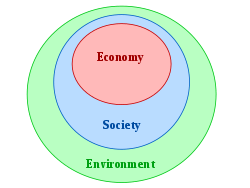- See also: Sustainable development
In ecology, sustainability is how biological systems remain diverse and productive. Long-lived and healthy wetlands and forests are examples of sustainable biological systems. In more general terms, sustainability is the endurance of systems and processes.
Quotes
- Quotes are arranged alphabetically by author
A - F
- The new paradigm may be called a holistic world view, seeing the world as an integrated whole rather than a dissociated collection of parts. It may also be called an ecological view, if the term "ecological" is used in a much broader and deeper sense than usual. Deep ecological awareness recognizes the fundamental interdependence of all phenomena and the fact that, as individuals and societies we are all embedded in (and ultimately dependent on) the cyclical process of nature.
- Fritjof Capra, Gunter A. Pauli (1995) Steering Business Toward Sustainability. p. 3 cited in: Elmer Kennedy-Andrews (2008) Writing Home. p. 13.
- These, then, are some of the basic principles of ecology—interdependence, recycling, partnership, flexibiility, diversity, and, as a consequence of all those, sustainability. ...the survival of humanity will depend on our ecological literacy, on our ability to understand these principles of ecology and live accordingly.
- Fritjof Capra The Web of Life (1996) "Epilogue: Ecological Literacy." p.304
- Two types of choices seem to me to have been crucial in tipping their outcomes towards success or failure: long-term planning, and willingness to reconsider core values. On reflection, we can also recognize the crucial role of these same two choices for the outcomes of our individual lives.
- Jared Diamond, Collapse: How Societies Choose to Fail or Succeed (2005): "On the fates of past societies facing problems of sustainability," p. 522
- The key to understanding the future is one word: sustainability.
- Patrick Dixon, Futurewise (1998)
- Unfortunately a large number of people in many countries are strongly opposed to green technology, for reasons having little to do with the real dangers. It is important to treat the opponents with respect, to pay attention to their fears, to go gently into the new world of green technology so that neither human dignity nor religious conviction is violated. If we can go gently, we have a good chance of achieving within a hundred years the goals of ecological sustainability and social justice that green technology brings within our reach.
- Freeman Dyson, Progress In Religion (2000)
G - L
- What scares me? The way the world is going. People seem to think that development is more important than sustainability.
- Ursula Goodenough, Uncommon Knowledge (2005)
- To find our steady state and solve the sustainability puzzle, we need to abandon the relentless quest for dominance. We need to abandon our visions of progress as growth... Only progress in diversity, equality, and beauty can stand the test of time. We need to live within our limits.
- Steve Hallett, The Efficiency Trap (2013)
- We have an economy where we steal the future, sell it in the present, and call it GDP [gross domestic product].
- Paul Hawken Top 10 Myths About Sustainability at mindfully.org, 2009.
- At the beginning of the 21st century peace has become pivotal to the survival of society as we know it. The major challenges facing humanity today are global – climate change, lack of fresh water, ever-decreasing biodiversity and over-population. It is hard to over-state the devastating effects that these problems will have on business unless global actions are taken that have the agreement of most nations. No nations or individuals will be untouched.
M - R
- Cybernetics is a young discipline which, like applied mathematics, cuts across the entrenched departments of natural science; the sky, the earth, the animals and the plants. Its interdisciplinary character emerges when it considers economy not as an economist, biology not as a biologist, engines not as an engineer. In each case its theme remains the same, namely, how systems regulate themselves, reproduce themselves, evolve and learn. Its high spot is the question of how they organize themselves.
A cybernetic laboratory has a varied worksheet - concept formation in organized groups, teaching machines, brain models, and chemical computers for use in a cybernetic factory. As pure scientists we are concerned with brain-like artifacts, with evolution, growth and development; with the process of thinking and getting to know about the world. Wearing the hat of applied science, we aim to create what Boulanger,' in his presidential address to the International Association of Cybernetics, called the instruments of a new industrial revolution - control mechanisms that lay their own plans.- Gordon Pask An Approach to Cybernetics (1961). p. 11. Partly cited in: A.M.E. Salazar, A. Espinosa, J. Walker (2011) A Complexity Approach to Sustainability: Theory and Application. p. 11.
S - Z
- Our deep urge to evolve to a more spiritually mature level of understanding and living, and to create a social order that promotes more justice, peace, freedom, health, sanity, prosperity, sustainability, and happiness, absolutely requires us to stop viewing animals as food objects to be consumed and to shift to a plant-based way of eating.
- Will Tuttle, The World Peace Diet (2005). Ch. 2
- THE TERM (Sustainability) HAS BECOME so widely used that it is in danger of meaning nothing. It has been applied to all manner of activities in an effort to give those activities the gloss of moral imperative, the cachet of environmental enlightenment. “Sustainable” has been used variously to mean “politically feasible,” “economically feasible,” “not part of a pyramid or bubble,” “socially enlightened,” “consistent with neoconservative small-government dogma,” “consistent with liberal principles of justice and fairness,” “morally desirable,” and, at its most diffuse, “sensibly far-sighted.”
- Eric Zencey, "Theses on Sustainability" in Orion, May/June 2010.
See also
External links
This article is issued from
Wikiquote.
The text is licensed under Creative
Commons - Attribution - Sharealike.
Additional terms may apply for the media files.
